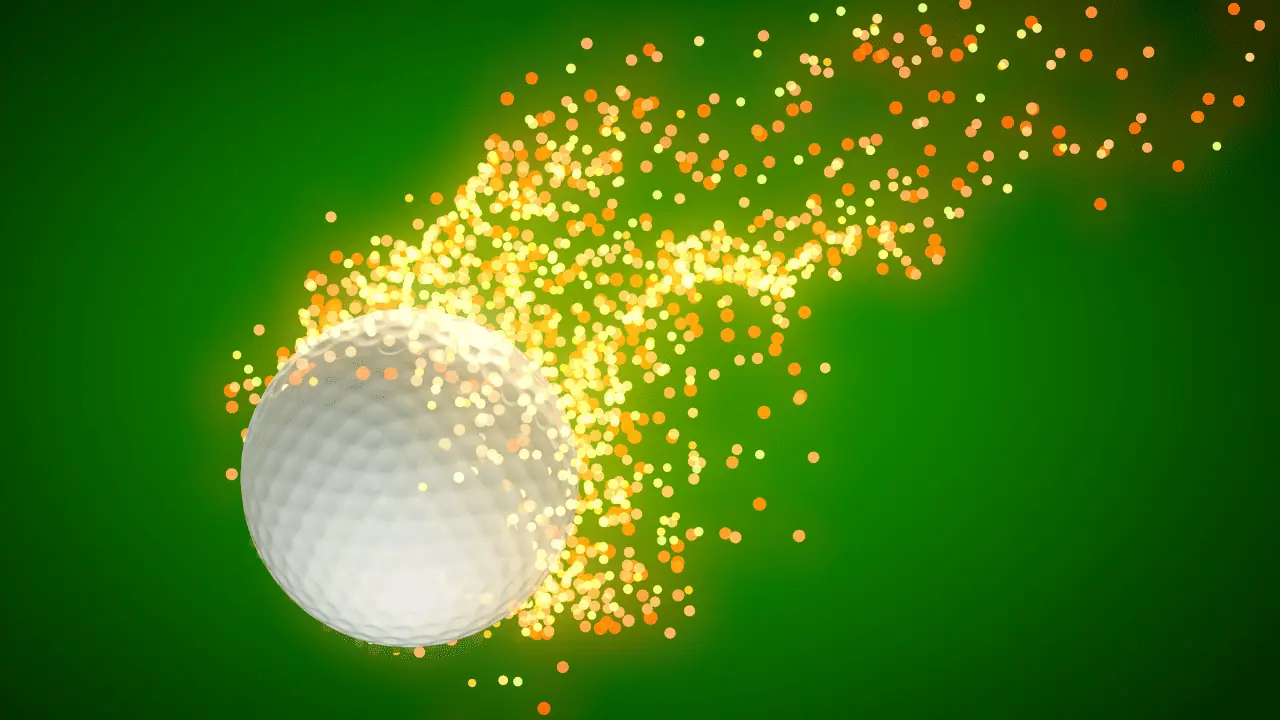Table of Contents
Until two years ago, I struggled to compress the golf ball at impact, reducing my smash factor and ball speed and increasing spin. In this post, I’ll teach you the relationship between driver ball speed to distance and how you can increase yardage from the tee box.
After walking away from this post, you will learn whether your average ball speed is fast, medium, or slow. I also reveal what ball speeds pros on the PGA Tour Champions and PGA Tour conjure up.

Driver Ball Speed to Distance Overview
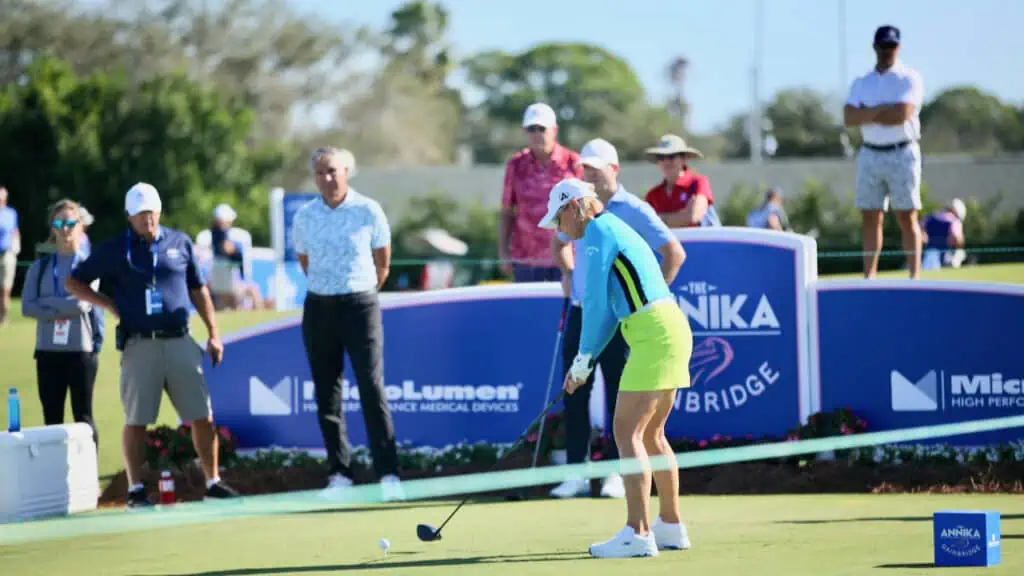
Driver golf ball speed and distance are impacted by factors including spin rate, attack angle, smash factor, and launch angle. Keep reading to understand how these metrics impact your distance and what you can do to boost your yardage.
What is Ball Speed in Golf?
Ball speed refers to the velocity your golf ball leaves the clubface at. It is regarded as a key factor impacting your distance, along with the spin rate, attack angle, launch angle, humidity, and wind. Your club head pace is transferred to the golf ball at contact, boosting acceleration for a powerful launch.
The faster your club speed is, the more ball speed you are likely to generate. However, striking the ball in the heel or the toe reduces your smash factor, energy transfer, and ball velocity, leading to a loss of distance.
How Do You Convert Ball Speed to Distance?
Converting golf ball speed to distance requires a strong smash factor, moderate launch angle, and favorable wind and precipitation conditions. When your clubface reaches impact, it transfers clubhead speed to the golf ball.
If you strike the ball out of the sweet spot, you should generate optimal velocity and a lower spin rate to elevate your ball into the air and produce a satisfactory carry distance. However, if you hit the ball excessively high in dry and windy conditions, you stand to lose length in the air.
Mishiting the ball lowers your speed and increases your spin rate producing a weak launch and a loss of distance. Therefore, a low launch angle and low spin will travel shorter than a higher launch angle with moderate spin, despite producing the same ball speed.
Ball Speed to Distance Chart
The below chart gives you a rough idea of carry distance relative to ball speed. The figures will vary depending on your smash factor, attack angle, spin rate, and launch angle. Using the example provided by Ping, we notice varying distances for a 167 mph ball speed.
When a player launches the ball between 7.5 to 8 degrees and produces 1600 rpm backspin, the golf ball flies 240 yards. Conversely, if the ball launches at 17 degrees with 2400 rpm spin, it delivers an average carry distance of 296 yards.
| Club Speed (mph) | Ball Speed (mph) | Spin Rate (rpm) | Carry Distance (yards) |
|---|---|---|---|
| 69 | 100 | 2500-3500 | 130-142 |
| 76 | 110 | 2400-3400 | 157-170 |
| 83 | 120 | 2300-3300 | 183-197 |
| 90 | 130 | 2200-3200 | 207-223 |
| 97 | 140 | 2100-3100 | 231-249 |
| 103 | 150 | 2000-3000 | 254-275 |
| 110 | 160 | 1900-2900 | 276-301 |
| 117 | 170 | 1800-2800 | 296-325 |
Read Next: Best Golf Drivers for Seniors + Buyers Guide
Driver Swing Speed Chart To Ball Speed
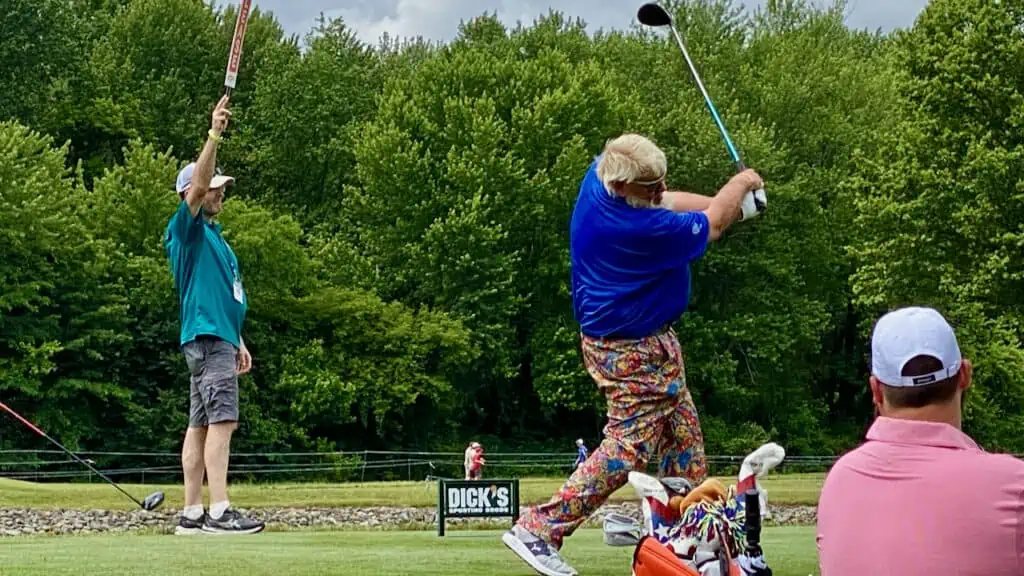
Take a look at the chart below to see how club head speed translates to ball speed. These metrics consider ideal conditions where you strike the ball cleanly, launch it optimally, and enjoy clear weather.
| Club Speed (mph) | Golf Ball Speed (mph) |
|---|---|
| 69 | 100 |
| 76 | 110 |
| 83 | 120 |
| 90 | 130 |
| 97 | 140 |
| 103 | 150 |
| 110 | 160 |
| 117 | 170 |
⛳️ Read Next: How to Use Golf Club Lead Tape
Average PGA Tour Player Ball Speed
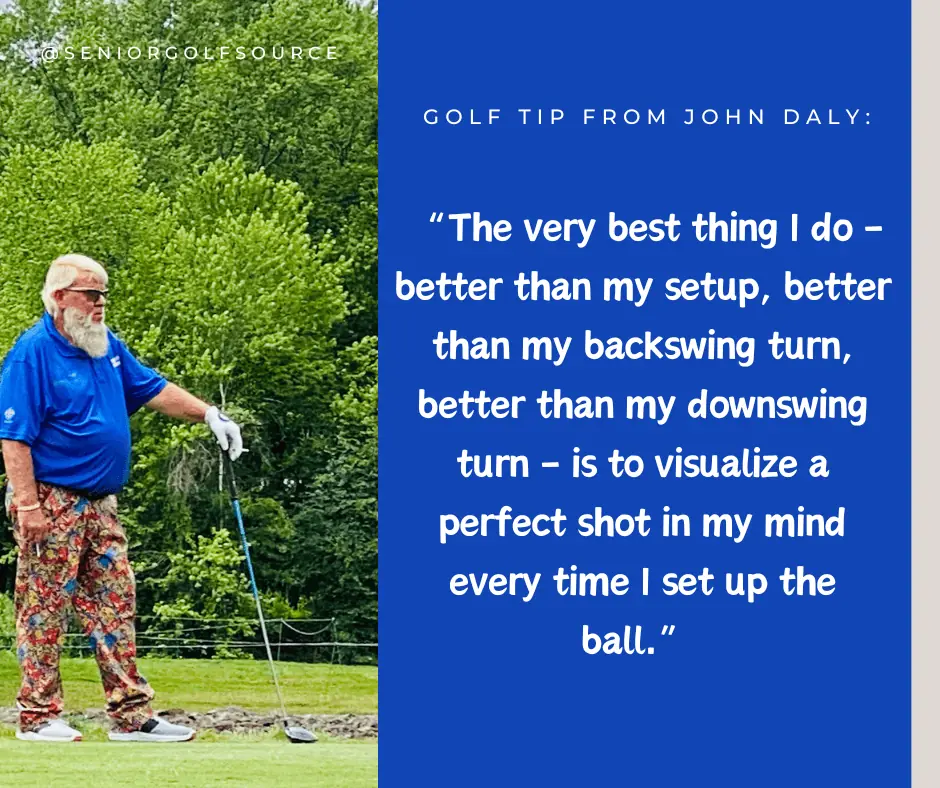
The ball speed chart below highlights the average PGA Tour player and their LPGA counterpart’s ball speed. Cameron Champ beats the average by approximately 17 mph, while Brian Stuard is behind the mark with an average of 157 mph.
Although little radar data is available on the PGA Tour Champions, I was impressed to see Padraig Harrington’s ball speed average. The Irishman generates 180 mph ball speed regularly. As a YouTube Channel instructor, he shares some of his favorite tips for increasing speed in the golf swing.
Miguel Angel Jimenez produces less ball speed than the PGA Tour average, notching up 165 mph. Impressive from the 60-year-old Spaniard.
Individual statistics on ball speed are few and far between for LPGA Tour pros. However, it is interesting to note that Nelly Korda conjures up 154 mph ball speed, 14 mph more than the LPGA Tour average.
| Golf Club | PGA Tour (MPH) | LPGA (MPH) |
|---|---|---|
| Driver | 173 | 140 |
| 3 Wood | 158 | 132 |
| 5 Wood | 152 | 128 |
| 7 Wood | 146 | 123 |
| 3 Iron | 142 | N/A |
| 4 Iron | 137 | 116 |
| 5 Iron | 132 | 112 |
| 6 Iron | 127 | 109 |
| 7 Iron | 120 | 104 |
| 8 Iron | 115 | 100 |
| 9 Iron | 109 | 93 |
| Pitching Wedge | 102 | 86 |
⛳️ Read More: Golf Club Distance Chart For Seniors
Club Head Speed vs Ball Speed: How Does it Affect Distance?
Accelerated clubhead speed is vital for optimizing energy transfer at contact to impart rapid pace onto the golf ball. The faster your ball speed is, the less spin you create and the better your chances are of an optimal launch angle and maximum carry distance.
Faster clubhead speeds typically hit further than slower swingers because they are able to deliver greater force at impact. However, if you mishit the ball and produce a weak smash factor, you lose ball speed and ultimately, distance.
Comparing my average metrics to Cameron Champ puts the club head speed and ball speed distance relationship into perspective. Champ averages 126 mph clubhead speed and 191 mph ball speed, prompting an average driving distance of 316 yards.
My driver clubhead speed averages 85 mph, ball speed 131 mph, and distance 273 yards. I lose 40 mph on Champ during the downswing, and even with consistent contact, my ball speed is over 60 mph slower than his. My total distance average is 43 yards shy of Champ’s average.

6 Expert Tips on How to Increase Ball Speed
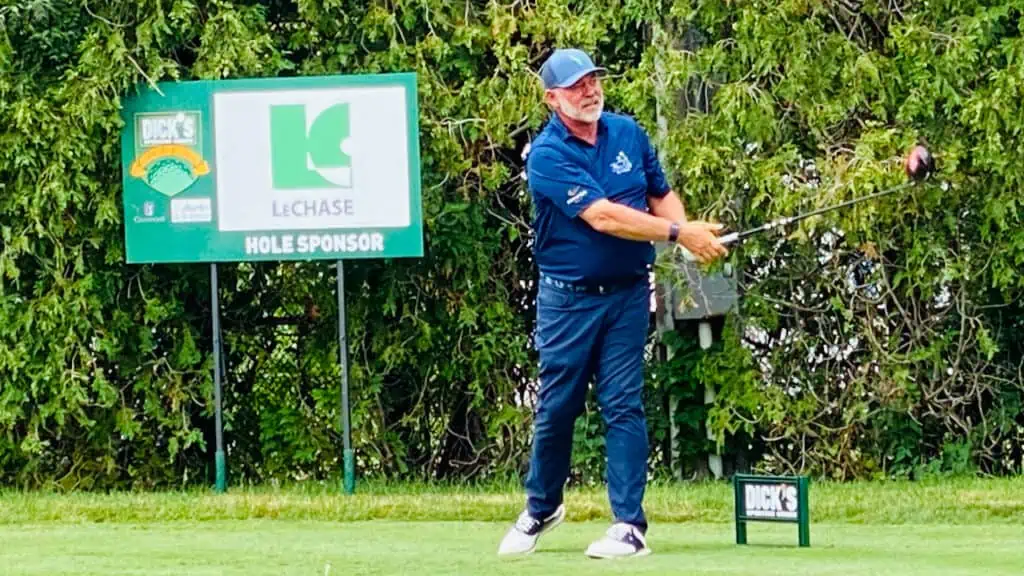
1. Use a Lightweight Driver
If your ball speed loss stems from slower clubhead speed, I suggest altering the components of your driver. Employ a lighter, flexible shaft to drop the swing weight and help you accelerate the club on the downswing.
Alternatively, seek a new driver with a lighter, flexible shaft and a lower swing weight.
The lighter construction will give you an added boost on the downswing and spring the clubface into the ball at contact. This boosts rebound off the clubface for reduced spin rates and explosive speed.
I recommend senior golfers consider the luxury of flexibility and high torque in a senior or ladies flex shaft. I also find drivers with lower swing weights around the D0 mark easier to unload for slow clubhead speeds.
⛳️ Read Next: Can’t Hit Your Driver? How to Hit a Driver Further Today
2. Shoulder Turn On The Backswing
Increasing clubhead speed is vital to generating rapid ball velocity. The faster you swing, the faster your potential ball speed is. The first part of conjuring pace in your swing is optimizing the rotation of your shoulders on the backswing.
As Rick Shiels explains, you want to boost your range of motion to get the clubhead as far away from the strike zone as possible. The farther your clubhead is from the ball at the top of the swing, the more distance you have to cover on the way down, setting the scene for explosive pace into impact.
This positions you to impart rapid zip onto the golf ball for a powerful launch and impressive carry distance.
3. Hip Rotation
Sticking with building up clubhead speed, I tend to rotate my hips as far as possible, away from the target on my backswing. It creates a coil and builds up ample energy for me to unleash on the downswing, generating an accelerated ball pace.
If I only turn my shoulders on the backswing and rely on my arms, I lose power and speed on the way down, prompting a weak strike. However, optimizing my hip rotation on the backswing helps me build up energy, which I can release from the top and accelerate into impact.
4. Smooth Transition
Once your clubhead reaches the top of your backswing, you should transition smoothly to your downswing to avoid losing power and speed. Often, amateurs rush the transition from the top, causing them to unload the club early and lose power.
By the time the clubface reaches the ball, it is slow and has minimal energy to transfer to the golf ball. I suggest working with a swing training aid like the Orange Whip to help improve your tempo for a fluid motion from takeaway through impact.
5. Wrist Flexion Prior To Impact
For most of my career, I lost ball speed at contact because of excessive wrist extension prior to impact. This caused me to open the clubface, weaken the loft and launch the ball high and to the right.
I started working with the HackMotion wrist training aid a couple years back, and it has done wonders for my ball speed. By training myself to flex my wrists on the downswing, I started shallowing the shaft and delofting the clubface to increase compression, ball speed, and accuracy.
6. Shallow Shaft
I was guilty of swinging steeply for two decades, which cost me clubhead speed on the downswing. It also led to the odd chunk and inconsistent strike, hampering my smash factor, ball speed, and launch.
Under the guidance of the HackMotion wrist sensor, I have managed to consistently shallow my club’s shaft, leading into impact. I bring my golf shaft parallel to the ground prior to contact, creating lag, delofting the club, and marginally closing the clubface.
My rotation and momentum whip the club from the parallel position into the golf ball, maximizing energy transfer, compression, and ball speed.
Frequently Asked Questions
What is my swing speed if my ball speed is 150?
Your golf swing speed is approximately 103 mph if you produce 150 mph of ball speed with an enhanced smash factor and launch angle. Your golf ball speed could also reach 150 mph with a 110 mph swing speed and a weak smash factor.
How fast does your ball speed need to be to hit 300 yards?
On average, your golf ball speed will reach over 170 mph if you are to hit your driver 300 yards. However, these driver distance metrics are based on clear days with limited wind or humidity.
How far should a 70 year old man hit a driver?
On average, I find 70-year-old men hitting a driver between 180 to 200 yards in perfect conditions.
Final Thoughts
After reviewing the connection between driver ball speed to distance, it is clear that multiple factors impact these metrics. Ball speed is determined by clubhead speed, angle of attack, smash factor, and spin rate. However, a rapid ball speed does not necessarily translate to optimal distance.
You require a medium to high launch angle, no wind, and some humidity to enjoy the perfect conditions for increasing yards off the tee. Just because your ball speed is explosive does not mean your ball will fly long.
The perfect tee shot requires rapid swing speed, a reduced spin rate, mid-to-high ball flight, and limited headwinds.

